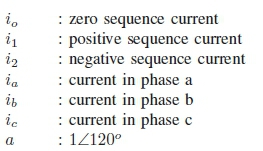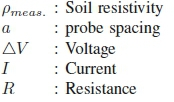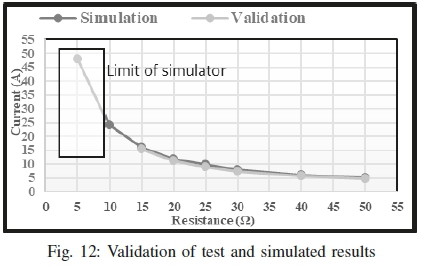Services on Demand
Article
Indicators
Related links
-
 Cited by Google
Cited by Google -
 Similars in Google
Similars in Google
Share
SAIEE Africa Research Journal
On-line version ISSN 1991-1696
Print version ISSN 0038-2221
SAIEE ARJ vol.110 n.4 Observatory, Johannesburg Dec. 2019
ARTICLES
An Alternative technique for the detection and mitigation of electricity theft in South Africa
Quentin LouwI; Pitshou BokoroII
IMember, IEEE
IIMember, IEEE
ABSTRACT
Electricity theft and illegal connection by ground surface conductors is a pervasive problem in South Africa. The impact this phenomenon has is not only limited to revenue loss and equipment damage, but also presents a life threatening hazard. Although the issues of non-technical losses have been researched for decades, no universal solution has been presented, due to the complexity of the problem. This paper investigates the application of zero-sequence current-based detection as a mitigation strategy to deal with illegal connections by ground surface conductors. Simulation and experimental results show the validity of this technique as well as its dependence on seasonal change of the soil resistivity.
Index Terms: Electricity theft, ground surface conductors, illegal connections, non-technical losses, soil resistivity, zero-sequence current.
I. INTRODUCTION
Electricity theft is a pervasive problem for supply authorities worldwide. Illicit actions contribute the largest form of non-technical losses (NTL). These losses may be defined as unnatural since they are neither caused by series impedance, nor by shunt admittance associated to power lines. They are usually attributed to theft, meter tampering or errors, administration inefficiencies, and non-payment of electricity bills. PennEnergy [1], records that each year 96 billion US dollars are lost worldwide due to NTL, and energy theft ranks third among the most commonly stolen items in the world. In the USA, NTL losses amount to 6 billion US dollar per year. The World Bank reports that energy theft in Sub-Saharan Africa is in the order of 50 % of the generated capacity, and further highlights that NTL may be as high as 1.2 % of the gross domestic product (GDP) of quite a few countries in the globe [2]. Recent studies, reported in [3] and [4], suggest that an emerging country such as India suffers approximately 16 billion US dollar per year in revenue loss as a result of NTL. In South Africa, NTL contribute in the range of 8 to 12 billion Rands in revenue loss annually [5]. Eskom [6], reports that revenue loss related to energy theft is actually closer to 20 billion per year. Furthermore, because of NTL, power utilities are compelled to compensate for power losses by generating more electricity in order to offset such losses, and the aggregate economic effect is unavoidably passed down to electricity payment compliant consumers (non-defaulters) which negatively impacts on the collective economy. NTL could also be associated to unplanned power outages as a result of phase imbalance introduced by illegal connection or unmetered supply [7], [8]. However, the consequences of electricity theft cannot be restricted to revenue losses and quality of supply. In fact, it is a huge problem in terms of the safety of people living in and around communities where electricity theft is common practice. The global perspective on the safety of these dwellings is further emphasised by the fact that, for instance, 50 people are electrocuted per week in one region of Eastern Uganda alone where electricity theft is attempted [9]. Electricity theft is thus an aggravating factor for NTL in South Africa, and has a variety of consequences beyond revenue loss and quality of supply. Besides revenue losses and deterioration in the quality of supply, safety and the risk to human life is often overlooked and therefore not considered. In 2017, 50 fatal incidents and 150 injuries attributed to electricity theft by means of illegal connections were reported [10].
In this work, zero-sequence current (ZSC) measurement in the star point node of a distribution transformer is used as an alternative way to detect energy theft, resulting from bare conductors lying on the ground surface. Furthermore, this work proposes to mitigate the risk of revenue losses, quality of supply, and risk to human life by virtue of distribution point node isolation. The findings presented in this work show that the philosophy of the proposed alternative technique could possibly be applied as a detection mechanism and mitigating strategy for NTL associated to electricity theft by ground-lying bare conductors.
II. Energy Theft Impact in South Africa
A. The South African Environment
The South African population recorded in 2017 is approx. 56 million people [11]. The country is divided into nine provinces of which Gauteng Province, the smallest of the nine, contributes the largest portion of GDP to the South African economy [12]. With the current unemployment figures of approximately 27 % [13], economic hardships are real and do disturb the socio-economic conditions of the population. With such economic pressures, populations migrate between provinces in a hope to address or find solution to their socioeconomic needs. This migration leads to high densities of population not being able to afford access to basic services such as electricity, water and sanitation. Since Government cannot always provide these services at insignificantly cheaper rates, this leads to communities taking matters into their own hands by establishing informal housing environments and connecting to existing or nearby power-supply grids without authorisation and/or necessary knowledge of utility companies. This creates volatile and unsafe environments.
B.Informal settlements and illegal connections
Informal settlements in South Africa are defined as housing structures built out of rudimentary materials, which have not been approved by the local authority planning department [14]. Furthermore, these structures are built on land that has not been proclaimed nor surveyed for human settlement, and they are then considered as illegal households, adding to the fact that basic services such as water, electricity and sanitation are not adequate. There are currently more than 100 recorded informal settlements in Gauteng alone and further statistics highlight that this province is home to approximately 25 % of the country population [15]. The economic attractiveness of Gauteng creates population densities where no electrical infrastructure is provided, and resulting in high densities where illegal connections are likely to occur.
C.Methods of illegal connections
Illegal connections are defined as electricity theft when connections are made from the power source to where it is needed [16]. In South Africa, these illicit actions are achieved by connecting directly to nearby lighting infrastructure, and, more importantly, to the distribution power transformer via a ground surface conductor, which is pertinent to this paper. One of the methods deployed and which is investigated in this paper, is the tapping of power from the low voltage (LV) backbone networks via ground surface conductors supplying the dwellings. Although it is reported that NTL in South Africa are mostly related to energy theft occurring in the business sector (54%) and less so in the residential sector (46%) [6], these illegal connections mostly occur in informal settlements (within the residential sector), where safety to the communities is of primary concern.
D.Impact of illegal connections in the South African context
The impact of illegal connections in South Africa can be defined as a collective of various elements: Social; Economic; Engineering; Health and Safety. The social and economic impact have already been discussed. What is of concern is the engineering and safety impact illegal connections represent. The engineering impact is illustrated in Fig. 1 which highlights the challenges that technical staff are faced with on a daily basis. Furthermore, these illegal connections cause major damage to network equipment and affect the quality of supply for compliant electricity users [6], [17], [18]. Currently in South Africa, there is no adequate detection nor protection applied to the distribution transformer LV terminals to detect these ZSC incidents, and the reliance of protection operation and node isolation is dependent on the LV protection (i.e. fuses or circuit breakers). In some cases, the fault isolation is referred to the medium voltage (MV) fuse protection through the transformation ratio. The problem with this philosophy is related to the magnitude of the expected ZSC, which is small compared to the general load conditions (on which fuse ratings are usually based) and the general overcurrent and earth fault expected levels. Therefore, these protection devices will not detect ZSC on the LV. Danger to human life is clearly indicated in Fig. 2 [19], where live wires lying on the ground surface amidst the community as they go about their daily chores. In this illustration, the illegally-connected wires are lying among the community while they fill containers with water. This figure represents the awareness that should be considered in terms of providing a safe and secure supply from power utilities. What is more concerning about this figure though, is that this scenario is depicted as an accepted way of living as it seems there is no regard for the dangers involved.

III. Overview of Electricity Theft Detection techniques
NTL detection techniques, such as suggested in the literature, show a multitude of possibilities, and as a consequence highlight the plausibility of energy theft mitigation. What is prevalent in the literature is that NTL are very difficult to detect using administrative means. The rationale is based on the calculations and verification of collected data. As an added consequence, the use of data mining with incorrect data samples integrated into measuring devices can be a futile and costly exercise [20], [21]. Various solutions to the associated problems have been proposed. All adopted strategies are geared towards the consumer point of supply (PoS), with a primary focus on revenue improvement. This situation presents challenges because of life hazards occurring in communities where illegal connections are common. Furthermore, under the current strategies employed, illegal connections are only mitigated when they have been physically removed. Communities are highly dependent on power theft, and this creates volatile and unsafe working conditions for engineering teams tasked with dealing with the problem of investigation and removals. The application of smart meter technologies is at the forefront of worldwide deployment; South Africa included, and is considered the generic mitigating solution to the problem of NTL [22], [23]. The benefit of deploying this technology greatly improves revenue management if administered well and is typically deployed at the consumers PoS where energy theft and billing unit tampering are detected. The application therefore contributes significantly to NTL revenue management. The smart meter strategy specifically addresses NTL as a mechanism to detect energy loss variances between the network supply and the PoS through energy balancing [20]- [22]. This application measures the energy variance and can therefore detect illegal connections in theory. However, it cannot detect ground surface conductors directly - only indirectly. Indirect detection would be a function of variance management in the supply and demand, and the dispatch of engineering teams to investigate and remove such illegal connections. The limitation this strategy presents, is in detecting how these energy variances occur - i.e. illegal connections by ground surface conductors or by aerial tapping of the LV network. Boosting the network supply voltage is another suggested application [23]. This strategy suggests an increase of the network supply voltage to 350V (phase to neutral), and then its reduction to 230V (phase to neutral) at each PoS with dedicated transformers. The benefit associated
with this strategy are attributed to a practical solution around the problem, as the phase-neutral voltages are considerably higher and may cause damage to appliances in the event of illegal tapping from the overhead line. Thus, this is a deterrent. The limitation with this strategy is, however, the cost associated with upgrading current infrastructure to comply with this proposed application and the dangers to communities associated with higher supply voltages. A time domain reflection (TDR) philosophy is another commonly proposed option. This application is reliant on impedance variance arising from a return frequency measured in accordance with the expected network parameter impedance. Based on these set parameters this technique can detect normal condition or possible theft of energy [24]. The benefit of this philosophy consists of its proven application as a detection technique in cable-fault management, and may therefore be applied in this particular instance. However, its limitation is that although it might detect such impedance variance because of illegal connections, it allows for high cost of deployment and relies on engineering teams to investigate and further remove such connections. Therefore, despite decades of research work in the detection and mitigation of electricity theft and NTL, no general solution has been adopted from the source end that clearly indicates the complexity of this problem. This also justifies further research opportunities in this topic in a bid to particularly address NTL by illegal connections because of bare conductors on the ground surface such as commonly encountered in South Africa.
IV. ALTERNATIVE PROPOSED TECHNIQUE
A. Topology of South African low voltage networks
The typical network topology deployed within the South African environment is highlighted in Fig. 3. The typical network arrangement for LV distribution of energy in electrification networks is terminated to the LV grid through a Delta-star vector group distribution transformer, which supply the remaining part of the LV grid with insulated bundled concentric cable to the household receiving end. This type of electrification infrastructure allows for the most attractive cost of deployment and is considered the benchmark for all electrification projects. The standard LV applied network voltages in this arrangement are typically 400 V phase-to phase and 230 V in the single-phase arrangements.

B. LV earthing arrangement
LV earthing in these networks is adopted by the IEC 60364 and SANS 10292 where the TN-C and TN-C-S configurations are used [25], [26]. This method of earthing allows for a PEN conductor (protective earth and neutral) to be used to ensure that the appropriate earthing is achieved in the household, and further allows for ZSC to return to the star-point of the distribution transformer in the event of an earth fault condition occurring. This is done to avoid the impact of the soil resistivity on the associated fault impedance and fault currents required for invoking protection operation. This earthing arrangement is shown in Fig. 4.

C. Zero-sequence current theory
Zero-Sequence Current (ZSC) is established once an earth fault condition occurs within a three-phase supply network. This type of fault is then considered to be an imbalance condition. The typical fault impedance arrangement is indicated in Fig. 5. In order for calculations to be performed, the impedance values under unbalanced fault conditions need to be determined. The Fortesque method is often applied to convert these asymmetrical conditions into symmetrical components that then allow for appropriate fault analysis to be performed [27].


Where:

The various sequence current components may be determined by linearisation of the matrix equation provided in (1). For an earth fault on phase a, the resulting fault current has proven to be three times the zero sequence current component (ia= 3 χi0). Furthermore, under earth fault condition such as outlined in Fig. 5, the total impedance consists of the summation of positive, negative and zero sequence impedances of all the network components including the fault current impedance path (3Zf). This can be expressed as follows:

Where:
Va: voltage in phase a
Z1 : positive sequence impedance
Z2 : negative sequence impedance
Z0 : zero sequence impedance
D. Measurement of zero-sequence current in the proposed mitigating strategy
The intended outcome of this paper is to demonstrate the use of ZSC as a possible detecting and mitigating technique for electricity theft detection. Fig. 6 (below) highlights the proposed measuring method for the detection of ZSC during ground surface conductor-based illegal connections supplied from the distribution source transformer [20]. The neutral terminal (n) and earth conductor are electrically bonded together at the supply point. Furthermore, this earth conductor is then placed into the soil by an earthing arrangement that would yield the least resistance possible - typically less than 10 Ω. This arrangement now provides for the electrical reference point of the system, as well as the path for ZSC to return to the source transformer.

A. Field soil resistivity tests
Soil resistivity tests were conducted at the outskirts of informal housing settlements found in Gauteng. A presuppose of these tests was multiple bare conductors on the ground surface (illegal connections) found within these environments. The test setup requirements to accomplish this task is illustrated in Fig. 7. The method employed was the Wenner test method, which allowed for an average of five recorded results to be tested over an average area of approximately 80 m2. The test involved applies the Chauvin Arnoux model 4630 measuring instrument to four electrodes driven into the ground at specific distances apart (a) and at a specific depth (d). The depths of the electrodes were calculated as a function of the electrode distance separation. A current source was then applied at the two outer earth electrodes and a voltage was measured over the two inner electrodes.

Temperature readings of the soil were also recorded as part of the testing sequence. The distribution of currents typically found within this test arrangement is shown in Fig. 8. The soil resistivity (ρ) is then recorded from the instrument, and


Where:

B.Digsilent-based simulation
The Digsilent software package version 15 was used to perform simulations of a simplified network. The network consisted of an external grid supplying an overhead conductor through an 11/0.415 kV Dyn transformer. Several types of ground faults were simulated over a range of resistance value assigned to the fault current path. The results obtained were compared to values obtained during laboratory experiments. The digsilent simulation arrangement is indicated in Fig. 9.

C.Laboratory experiment
A schematic of the test setup is shown in Fig. 10, while the simulator, such as physically used in a laboratory environment for validation testing [29], is indicated in Fig. 11. The test setup involved used a bespoke Dyn11 transformer with a ratio of 1 (415:415) and impedance of 4%. This arrangement allowed for a connection to be made to the external 3-phase, 4 wire local authority supply grid. The transformation ratio was specifically chosen, as this allowed for the simulator to represent actual LV voltages, and allowed for the test simulator to be isolated from the main grid. Two 100 Ω 15 W variable resistors were connected in parallel to achieve the desired calculated ohmic values required for the test. These ohmic values represented the actual values of soil resistances deduced from field tests. The resistances were then calibrated to the specific required values, and then connected between the transformer star point and the various phase configurations required for validation of all tests. All currents were measured using current transformers (CT) appropriately placed within the test setup and the associated voltages were recorded with handheld voltmeters.


VI. RESULTS AND DISCUSSION
The following results were recorded for the various tests conducted. These results included the soil resistivity field tests as given in Table I, the ZSC Digsilent simulation results as provided in Table II, the laboratory measurement results of ZSC such as provided in Table III, as well as the ZSC comparative curve given in Fig. 12. From the results obtained, the following findings are presented: The ZSC versus resistance graph such as presented in Fig. 12 demonstrate the validation of the findings obtained in the laboratory experiment relative to the Digsilent simulation. This validation was limited to the simulators testing abilities, as resistances lower that 15Ω would yield currents larger than what the test simulation could produce. This limitation was accepted, as the interest in the test was to understand current values in the larger resistance ranges. It could be observed that resistance values larger than




30 Ω will lead to currents lower than the anticipated ZSC measurement of 5A. This 5A limit is identified as the conventional lower limit for ZSC mitigation of illegal connections by ground surface conductors. The most significant factor in the total ZSC fault impedance equation is the variable characteristic of soil resistivity condition. The test conditions done with various types of soil conditions (i.e. moist to dry), find that in soil conditions such as moist, the resistivity values yield better results (compared to dry soil conditions). This observation is important, as these tests were conducted during the South African winter season (June-July), and in South Africa most of the soil conditions are attributed to clay-sand, which has a better water retention property. However, soil resistivity is directly affected by temperature such as discussed in [30], [31]. In colder environments, water is drawn from the surface of the soil, so increasing the resistance, while as the soil heats up due to exposed solar radiation; water is drawn to the surface, thus reducing the soil resistance once again. However, this phenomenon is directly proportional to the rain season of the area. Should this area be exposed to prolonged drought, water evaporation would eventually take place and increase soil resistance once again.
VII. CONCLUSION
Illegal connections in South Africa are a pervasive problem perpetuated by socio-economic conditions, lack of political will, and unemployment. Although much has been done to mitigate these issues, government cannot sustain the demand for housing and the associated basic services required by the communities, due to slow infrastructure development progress and population migration patterns. This paper sets out to propose an alternative strategy using ZSC to detect and mitigate illegal connections specifically because of bare conductors lying on the ground surface scenario. For decades the issue of NTL and electricity theft has been the focus of continued research. Most of the focus has been on dealing with the point of supply at the customer end, rather than also considering the consequential safety effect the illicit acts present. With the advent and deployment of smart metering technology systems, which primarily focus on revenue improvement, energy balancing can be applied to detect NTL due to perceived electricity theft. This philosophy however has limitations, as it depends on accurate network data (data mining) and demand load management patterns, and furthermore cannot detect and isolate the primary supply node, should these illegal connections occur. The only way to deal with these illegal connections, using this approach, is to dispatch engineering teams to investigate and remove the illegal connections which is problematic as the acts of removal initiate volatile environments for the teams to operate under, and this therefore further escalates the safety risk. The alternative proposed ZSC philosophy does not consider load demand patterns in the decision-making algorithm and can therefore be applied as a detection and mitigation strategy. The presence of ZSC due to ground surface conductors can be measured in the star-point of the primary supply node. With the proposed IED (Intelligent Electronic Device) development installed, dispatch alarms can isolate the affected node automatically, so mitigating the safety aspect and NTL losses. The South African OHS Act 85 of 1993 requires that electrical supply utilities ensure safe network supply at all times, and as is the case with illegal connections this becomes very challenging if not impossible to deal with, and therefore engineering solutions need to be found to mitigate this through a collective approach, supported by government and supply authorities.
VIII. FUTURE WORK
Future research is currently being undertaken to further understand the effect ZSC has in the practical environment. This work will concentrate on establishing the true ZSC component fundamentals based on field data compilations measured over time, and therefore a design and implementation of an algorithm integrated into a bespoke measuring device that will intend to alarm or possibly isolate the affected supply node as a result of illegal connections by ground surface bare conductors.
References
[1] S. Foster, "Non-Technical losses: A 96 billion US dollars global opportunity for electrical utilities," available on https://www.pennenergy.com/articles/pennenergy/2017/11/non-technical-losses, accessed on July 2018.
[2] P. Antmann, "Reducing Technical and Non-Technical Losses in the Power Sector," Background Paper for the World Bank Group Energy Sectors Strategy, July 2009.
[3] https://www.tradingeconomics.com/south-africa,electric power transmission and distribution losses in selected countries, accessed on December 2016.
[4] Northeast Group, "Emerging Markets Smart Grid: Outlook 2015," available on https://www.northeast-group.com. Accessed on July 2018.
[5] M. J. Rhode, "Revenue Protection Strategies in South Africa and surrounds," 18th Annual Convention on South African Revenue Protection Association (SARPA), Knysna, South Africa, July 2014.
[6] Eskom Operation Khanyisa fact sheet. "The Power is in Your Hands," available on www.eskom.co.za. access on March 2017.
[7] H. N. Amadi and E.N.C. Okafor, "The Effects of Technical and NonTechnical Losses on Power Outages in Nigeria," International Journal of Scientific & Engineering Research, vol.6, no.9, pp. 45-49, September 2015. [ Links ]
[8] Eskom."Electricity that causes power cuts," available on https://www.iol.co.za/dailynews/illegal-connections-the-leading-cause-of-unplanned-power-outages-says-eskom. accessed on April 2019.
[9] P. Lindrio, "In Uganda, Theft of Power Turns Deadly for Many, Despite Danger Warnings," available on www.globalpressjournal.com/health segment, accessed on March 2017.
[10] CAJ News. "50 killed in illegal electricity connections in SA, Es-kom deprived of R20 billion from criminal activities," available on http://www.weeklyxpose.co.za/2017/10/16, accessed on July 2018.
[11] P. Lehohla, "Statistics South Africa: South African National CENSUS statistical release P0302 Mid- year population estimates 2015," 2015.
[12] STATS SA, "Gross Domestic Product 4th Quarter 2017," Statistics release, 2017.
[13] STATS SA report P0211, "Quarterly Labour Force Survey," 2014.
[14] T. Gaunt, M. Salida, R. Macfarlane, S. Maboda, Y. Reddy and M. Borchers, "Informal Electrification in South Africa Experience, Opportunities and Challenges," Sustainable Energy Africa, Cape Town, 2012.
[15] The Housing Development Agency (HDA), "Informal Settlements in Gauteng," Research Report, 2013.
[16] T. B. Smith, "Electricity theft: a comparative analysis," Energy Policy 32, 2004.
[17] I. E Davidson, "Evaluation and effective management of Non-Technical Losses in electrical power networks," Proceedings ofthe IEEE Africon, George, South Africa, October 2002.
[18] P. Glauner, C. Glaeser, N. Dahringer, P. Valtchev, R. State and D. Duarte, "Non-Technical Losses in the 21st Century: Causes, Economic Effects, Detection and Perspectives," Technical report, University of Luxembourg, Luxembourg, 2018.
[19] Q. E. Louw, "Zero-Sequence current-based detection of electricity theft in informal settlements," Mtech dissertation, Dept. Electrical Eng. Tech., University of Johannesburg, South Africa, 2017.
[20] H. E Kassem, M. Badr and S.A Ahmed, "Reduction of energy losses in electrical distribution systems," Proceedings of the 24th International Conference on Electricity Distribution (CIRED), Stocholm, Sweden, June 2013.
[21] C. Selvapriya, "Competent Approach for Inspecting Electricity Theft,"International Journal ofInnovative Research in Science, Engineering and Technology, vol. 3, Special Issue 3, pp. 2347-6710, March 2014. [ Links ]
[22] W. A. Doorduin, H.T. Mouton, R. Herman and H.J. Beukes, "Feasibility Study of Electricity Theft Detection using Mobile Remote Check Me-ters,"Proceedings ofthe IEEE Africon, Gaborone, Botswana, September 2004.
[23] P. R. Babu, B. Sushma and A.B. Kumar, "HVDS Approach for Reducing the Technical and Non-technical Losses to Enhance the Electrical Distribution System Performance,"5thIEEE International Conference on Power Electronics (ICPE), Delhi, India, December 2012.
[24] A. Pavic, M. Stojkov and K. TrupiniC, "Illegal Connection Location on Main Power Cable,"Proceedings ofthe IEEE MELECON, Dubrovnik, Croatia, May 2004.
[25] IEC 60364-1. Low-voltage electrical installations Part 1: Fundamental principles, assessment of general characteristics, definitions, ed. 5.0, 2005.
[26] SANS 10292:2013. South African National Standards, Earthing of Low- Voltage (LV) Distribution Systems.
[27] G. Chicco and A. Mazza, "100 Years of Symmetrical Components," Energies 2019, vol.12, no. 3, pp. 450-470, January 2019. [ Links ]
[28] https://www.appstate.edu/marshallst/GLY3160/lectures/12: Resistivity, accessed on August 2018.
[29] Q. Louw and P. Bokoro, "Soil resistivity: field tests and estimation of zero-sequence currents," Proceedings ofthe IEEE Africon, Cape Town, South Africa, September 2017.
[30] Soil resistivity measurements. Available on http://www.lmrsitestandard.com. Accessed on September 2018.
[31] Q. Louw and P. Bokoro, "A limiting determinant to zero-sequence currents for grounded conductors in South African low voltage networks," Proceedings ofthe International Conference on renewable energies and power quality (ICREPQ'17), Malaga, Spain, April 2017.
Q. Louw is Ph.D student with the Department of Electrical and Electronic Engineering Technology, University of Johannesburg, South Africa. Email: 809088334@student.uj.ac.za.
P. Bokoro is Senior Lecturer with the Department of Electrical and Electronic Engineering Technology, University of Johannesburg, South Africa. Email: pitshoub@uj.ac.za.

Quentin Louw received the BTech and MTech degrees in Electrical Engineering from the University of Johannesburg in 2014 and 2016, respectively. He is currently pursuing the Ph.D. degree in electrical engineering at the University of Johannesburg. He is currently the chief executive officer of Ntamo Technologies. He holds membership with the Institute of Electrical and Electronic Engineers (IEEE) and the South African Institute of Electrical Engineers (SAIEE). He is also professionally registered with the Engineering Council of South Africa (ECSA). His research interests entail risk analysis and mitigation of non-technical losses in power system infrasctructures.

Pitshou Bokoro received the B.Tech. and M.Phil. degrees in electrical engineering from the Durban University of Technology, in 2006 and the University of Johannesburg in 2011, respectively. He completed the Ph.D. degree in electrical engineering from the University of the Witwatersrand, Johannesburg, in 2016. He is currently a senior lecturer in the department of electrical and electronic engineering technology of the University of Johannesburg, and holds membership with the institute of electrical and electronics engineers (IEEE) as well as the South African institute of electrical engineers (SAIEE). He is also professionally registered with the Engineering Council of South Africa (ECSA). His research interests include condition monitoring and reliability analysis of surge arresters, power transformers, power quality, dielectrics and electrical insulation and renewable energies.














